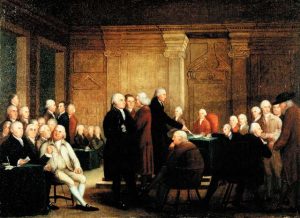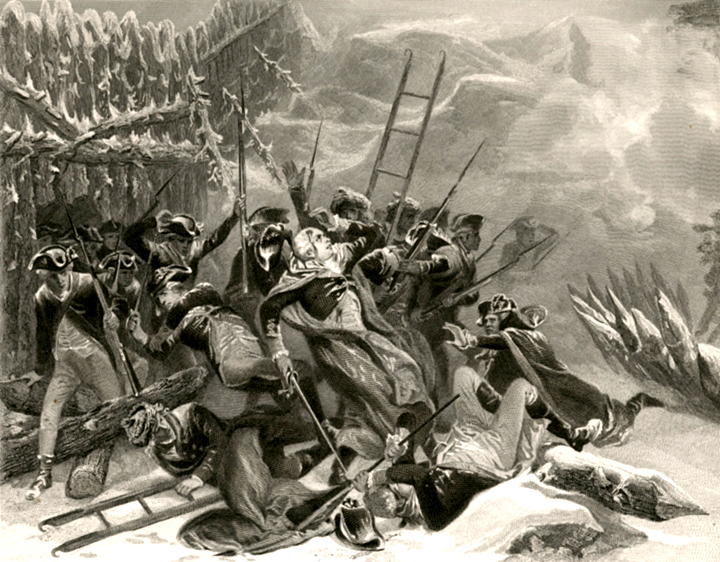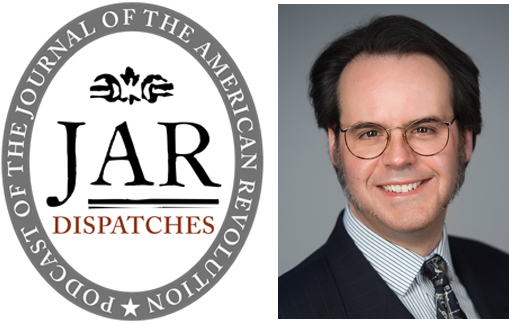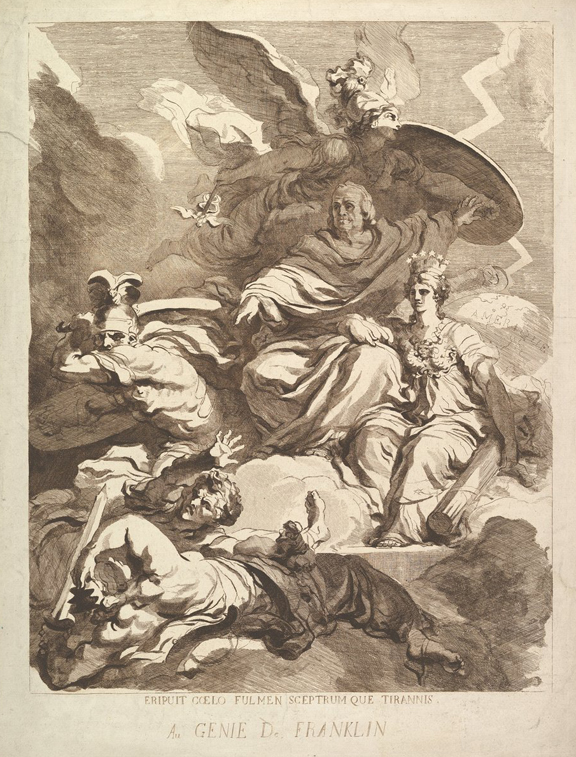
In popular media, the soldiers of the Revolution and the members of the Continental Congress generally take center stage. It’s actually not fair; John Adams gets a full length series on HBO and yet the workings of local government during the most trying time in our history barely make a footnote. In point of fact, the provincial governments, known as Committees of Observation and Inspection, during the Revolution played as large a role—perhaps one that was more important—than did Congress. Indeed, without the Committees of Observation, it is likely the Revolution would never have started.
During the Revolution, the town of Easton, Pennsylvania—populated with mainly German and some Scotch-Irish immigrants—was a bustling center of commerce and government during the greatest period of trial in the history of our country. Easton was right in the middle of the conflict. With its warehouses, it became a supply depot and produced goods for the war. Due to the ferry that crossed the Delaware, it became a staging area for soldiers and munitions during campaigns in New York and New Jersey.
As the County seat of Northampton, Easton held all the judicial and legislative power for miles around. In the early winter months of 1774, the people of Northampton County marched upon the Court House in the center of town. They destroyed the property of the parliamentary officials and ransacked their homes until they surrendered their power to local Continental leaders. Essentially at the end of a sword, the broken and humiliated men wrote public apologies before being escorted out of town, being forced to move to regions that were more friendly to Loyalists and Tories.[1]
On the 21st of December of that year, “agreeable to Notice for that purpose given to the Freeholders and Freemen of the County of Northampton qualified to vote for Representatives in the Legislature, a very respectable number of them met at the Court House in Easton…”[2] to elect the judicial body responsible for overseeing elections. Three men were chosen by popular vote to fulfill this role. Another 26 men, about one from each township in the County, were chosen to sit upon the newly-formed legislative body: the Committee of Observation and Inspection. They chose members to fulfill the roles of Secretary and Treasurer, and then adjourned. A few weeks later, on January 9th, 1775, they then had the task of choosing which of their members would become delegates to a special meeting in Philadelphia.
Many of the duties of the Committee were defined and necessary. These duties included keeping the borders secure by overseeing the frequency of patrols, standing over judicial issues for local citizens, printing any and all official resolutions passed by Congress in the local papers in German and English, and electing County Lieutenants whose job it was, along with the Committee, to make sure supplies were delivered to the County militia and Continental troops from the County.
But the job of the Committee of Safety was not glorious. Throughout their tenure, the Committee was responsible for keeping up the war effort, which meant finding the money to equip and arm any enlisted man they put into the field. Life had been trying. As a consequence, many decisions left to the Committee were morally and ethically questionable, even to the County people of the time.

As a Revolutionary government, keeping political opponents out of the picture was the one sure way to insure that the war would succeed. All were under the watchful eye of an appointed Sherriff and County Lieutenants. Anyone speaking ill of ‘the cause’ were systematically rounded up by local militia, brought into the Committee to stand trial and explain themselves.[3] They were then faced with a choice: sign a form recanting any negative words and deeds or have their names published in public forums as enemies of the people. Most chose to sign the form, others were thrown in jail or had their lands repossessed by the Committee and were run out of town.
Other duties, which were absolutely vital to the war, included procuring firearms, ammunition, and gunpowder. None of this was easy to accomplish. Gunpowder was difficult to produce in the colonies. While Pennsylvania had a mill for a time it could not keep up with the demands of the militia and regular army needs.[4] During the siege of Boston, for example, the Continental army’s supply of gun powder was so abysmal that Washington had to come up with a lie in order to prevent riflemen from wasting their powder to take pot-shots at wayfaring British Regulars.[5] And when supplies ran dangerously low as skirmishes around the city increased and the siege progressed, men were handed large, sharpened, wooden pikes instead of gunpowder and ammunition, just in case of an assault on their defenses.[6]
Rifles and muskets were even more difficult to acquire. Local gunsmiths were forbidden to enlist for service in Northampton and were put to the task of manufacturing firearms, yet many that were produced were a mish-mosh of cobbled-together pieces that neither functioned on the same level of the legendary Brown Bess muskets that were used by the British Regulars or the Pennsylvania Rifles that were used by marksmen. And none of the overburdened gunsmiths could supply the necessary amount needed to outfit the militia and the regular army troops for Northampton.
As a result, the Committee of Observation kept records of who in the County owned their own firearms and would frequently send out militiamen and a County Lieutenant to take all firearms from farmers and Non-Associators (anyone who refused to enlist, regardless of the reason), even those who were not under suspicion of being Tories had to give up their firearms and munitions or face jail time, a hefty fine, and public embarrassment. In several instances, the Committee of Observation put to trial those who refused. Such was the case with a series of men from Plainfield Township in Northampton County; from the Minutes of the Committee of Observation, dated to the 26th of July, 1776:
[These men] having been summoned by this Committee to appear before them to show cause why they refuse to deliver up their fire arms, they being Non-Associators, and they condemning the Authority of this Committee refused to pay any obedience to their summons. And upon a New Ordinance of Convention Colonel George Taylor sent to the house of Joseph Stackhouse the Elder to disarm him and his said sons a party under the Command of Capt. John Nelson, who accordingly brought them to Easton [Jail]. And the two Sons being now brought before this Committee for examination respectively say as follows, viz; Joseph the son declares that he sold his Rifle to his brother Robert and that it is in the possession of his brother. And the said Robert declares that he has in his possession the said Rifle also a Musket or Gun of his Grand Father and his own Rifle and that they are all loaded and that he would discharge them, against those who would take them out of his hands. Therefore the said Robert stands committed with his Father who is so refactory & inflexible that he will not give this Committee the least satisfaction in the matter: And the said Joseph the Son is discharged upon paying cost.
In other words, when the individual refused to accept the authority of the Committee and refused to turn over his firearms to Collectors nominated by the Committee, he was thrown in jail. This was no isolated incident either. Those who were innocent were released, but only after paying the costs associated with calling the Committee together and whatever fines were accrued.
Nevertheless, the Committees had to make do with what resources they had, and they were not always successful. In Lancaster, the Committee of Observation could not adequately equip their militia in 1777, and George Washington actually sent them back to Lancaster because they showed up to his camp without any firearms.[7]
In the early months of 1777, the new Pennsylvania Assembly passed a radical measure for the time, requiring all men of eligible age to serve in the militia, known as the Militia Act. The Act, essentially a draft, instituted a system whereby certain ‘classes’ of men from every county were called to serve a certain amount of time or ‘tour of duty’. Those who refused to serve had some choices; they could call upon a substitute to replace them for a tour or they had to pay a hefty fine.[8] Those who refused both were arrested and thrown in jail as ‘Traitors to America’. The men of the Committee of Observation were responsible for maintaining rosters and muster rolls of all classes who were called to service.
But it wasn’t just matters of war with which the Committee of Observation had to deal; the local matters of town had to be dealt with and those responsibilities fell also to the Committee of Observation. Returning to the winter months of 1777, the town of Easton was jam-packed with food and wares merchants, stacks of supplies for the army, teamsters and loads of wagons, soldiers on their way to and from their tour assignments, Native American traders, Hessian soldiers captured at Trenton—who incidentally were permitted to walk around town and purchase their own goods provided that they had money—as well as British and Hessian officers on parole living in and around the town in private residences, and of course the regular population on top of it all. Easton was a pretty busy place.[9]
Then during this time, the Director General of the ‘Hospital Department’, Dr. William Shippen, Jr., wrote to the Committee that several hundred sick and wounded soldiers would be sent to the hospital established in the Reformed Church in town. This is on top of the several hundred wounded and dying soldiers that had been sent to Easton in 1776 following Washington’s retreat back across the Delaware from New Jersey into Pennsylvania and the hundreds of wounded and sick Hessian soldiers that crowded the Jail and also Court House where the Committee had to hold its meeting. Committee members were assigned the grim duty of dealing with the near naked soldiers being dragged in on the backs of open-top wagons in the harsh winter elements. And they had to deal with the dead and dying—where to put them, where to bury them, and so on.
Hard decisions were made again; food and clothing were scarce. What was left that was not distributed to the militia regular troops would be distributed to wounded Continentals, leaving many of the prisoners to die. The Committee had also been forced to permit some Hessian prisoners to work on local farms, at times to relieve the issue of an overcrowded jail and Court House but also because so many men had left for tours that helpers were needed in order to continue to keep up with the crops and produce. These decisions were not left unnoticed either. When Philadelphia had been occupied by the British, the official correspondence and documents kept there were personally transferred to the hands of the Committee of Safety at Easton.[10]
 It should be noted here, however, that the Committees did an extraordinary thing; with their civilized demeanor, their care to do things by the law, they prevented the Revolution at home from becoming a bloody cacophony of mob brutality. The Committees did permit tactics of humiliation, they accepted that some questionable acts were to be permitted in such a period of strong emotions—for example the ransacking of the homes of Loyalists—but they were instrumental in stopping the riots before the angry mobs took lives. It is in this particular way that the Committees of Safety were so successful. By giving the people a voice, having representation locally, the high emotional reactions to the crown were tempered.
It should be noted here, however, that the Committees did an extraordinary thing; with their civilized demeanor, their care to do things by the law, they prevented the Revolution at home from becoming a bloody cacophony of mob brutality. The Committees did permit tactics of humiliation, they accepted that some questionable acts were to be permitted in such a period of strong emotions—for example the ransacking of the homes of Loyalists—but they were instrumental in stopping the riots before the angry mobs took lives. It is in this particular way that the Committees of Safety were so successful. By giving the people a voice, having representation locally, the high emotional reactions to the crown were tempered.
No matter how inaccurate the movie The Patriot is, the image of Mel Gibson running about shooting Redcoats in a half-unbuttoned shirt with three muskets and a series of pistols has become the quintessential image of the Revolution. But in truth, the hard struggles of the Revolution—its successes and its failures—did not just fall on the shoulders of Congress and the battle-weary soldiers. It rested squarely on the backs of the Committees of Observation, whose job it was to keep the peace at home, equip an army of undisciplined men, all while fearing that at any point the British Regulars would march into town and hang them all as traitors to the crown. These men are as much founders as George Washington and John Adams. They helped create a system of democracy that we still have, to a large degree, in place today; they made decisions as they had to in order to maintain what power they had in order to keep the Revolution going and yet for all their efforts they have been marginalized and ignored. In this author’s humble opinion, that is a tragedy unto itself.
[1] Much as is described by Ray Raphael, ‘The True Start of the American Revolution’ in Journal of the American Revolution Vol. 1, ed. Todd Andrlik et al. (Yellow Springs: Ertel Publishing, 2013), 24-25.
[2] Minutes of the Committee of Observation and Inspection (Easton: Easton Public Library Press), 1.
[3] Most notably the Tory, Robert Lettis Hooper, Jr., which is discussed in E. Wayne Carp, To Starve the Army at Pleasure: Continental Army Administration and American Political Culture, 1775-1783 (Chapel Hill: UNC Press, 1990), 3-5.
[4] Jimmy Dick, ‘The Gunpowder Shortage,’ Journal of the American Revolution (2013), accessed January 11, 2014, https://allthingsliberty.com/2013/09/the-gunpowder-shortage/.
[5] George Washington, The Writings of George Washington, ed. Worthington Chauncey Ford (New York and London: G. P. Putnam’s Sons, 1889). Vol. III (1775-1776). Chapter: 1775. Specifically the letter dated 14 August, 1775.
[6] Hugh T. Harrington, ‘Bows and Arrows – Pikes and Spears,’ Journal of the American Revolution (2013), accessed January 11, 2014, https://allthingsliberty.com/2013/09/bows-and-arrows-pikes-and-spears/.
[7] See the letter from President Reed to General Lacey, October 3rd, 1781, in Samuel Hazard, ed., The Register of Pennsylvania, Vol. 3 (Philadelphia: W.F. Geddes, 1829), 359.
[8] See the full discussion in Hannah Benner Roach, ‘The Pennsylvania Militia in 1777,’ The Pennsylvania Genealogical Magazine Vol. 23, No. 3 (1964), 161-229.













2 Comments
Good article on an important and under-emphasized aspect of the war. I would suggest the committees in the South (called Council of Safety at the provincial level and committee of safety at the parish/county level) were even more critical than their counterparts in the North for two reasons – and not just because it’s the subject of my dissertation:) First, there really was never much of a Continental Army presence in the South until Greene (for understandable reasons – both sides chose to fight in the North). This was particularly the case after the British moved South in late 1778. Lincoln’s army remained mostly in Charleston for more than a year as the British moved through Georgia and nearly to the gates of Charleston before falling back until the conquest of Charleston, when Lincoln’s army fell. Gates came south with a new army 3 months later and almost immediately lost it. Then it was another 4 months before Greene came south. In the meantime, partisans like Marion and Sumter get all the credit for holding off the British, but in the scholarship it is almost like they appeared out of a vacuum. It was because of much of the work these councils/committees of safety (as well as the Provincial Congresses) did dating back to 1775 that the British were never fully able to wrest control of the population away from the rebels even as they won conventional victories in 1778-1780. So while the conventional American army was missing for most of the war, it was these committees/councils that helped win the war.
The second reason I would argue they mattered even more in the South was because fundamentally they were about controlling the population – both for their own purposes (ie. recruiting, supplies, etc.) and to prevent the enemy from implementing their strategy (ie. controlling movements of Loyalists and British government officials, forcing signatures for the Association, etc.) This population control was particularly important in the South where British strategy was entirely reliant on that very same population to a degree it wasn’t in the North. Yes, Tories and Whigs fought each other with no less savagery in the North, and each side’s army used their militia and civilian counterparts where they could – but almost always in support of the conventional military strategy. In the South, the British shifted strategy and needed Loyalist support for their new strategy to even work. They were never able to get this support – not because there weren’t enough Loyalists as has often been suggested, but because from the very start of the war the rebels used these committees and councils for the purposes of population control that stymied British efforts 3+ years later (in large part because they didn’t understand the rebel strategy and thought they just needed to win big conventional battles for the Loyalists to come out of hiding).
Again, good article.